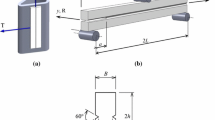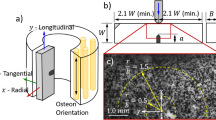Abstract
An accurate understanding of fracture in human bone under complex loading scenarios is critical to predicting fracture risk. Cortical bone, or dense compact bone, is subject to complex loading due to the inherent multi-axial loading conditions, which are also influenced by the anisotropy of the microstructure. When determining critical fracture parameters, bone is traditionally idealized as isotropic. This paper presents a method to examine rate-dependent mode mixity associated with cortical bone crack initiation. Four-point bend experiments have been conducted on cortical femoral bone samples from three human donors at quasi-static (slow), intermediate, and dynamic loading rates. Digital image correlation was used to obtain full-field displacement maps at the crack tip during the experiments. An over-deterministic least squares method is presented and used to evaluate Mode I (opening) and Mode II (shear) stress intensity factors (SIF) for fracture initiation at slow (10\(^{-2}\) MPa-m\(^{1/2}\)s\(^{-1}\)), intermediate (15 MPa-m\(^{1/2}\)s\(^{-1}\)), and high (\(4.5^{4}\,\hbox {MPa-m}^{1/2}\,\hbox {s}^{-1}\)) stress intensity factor rates. Results show that under dynamic loading, the critical SIF in Mode I assuming material anisotropy is approximately 50 % lower than fracture toughness assuming isotropy. Additionally, critical Mode I and II SIFs had the lowest values at the highest rate of loading examined, decreasing to one third of the values under quasi-static loading. Crack growth in the low and intermediate SIF rates appears to be Mode II dominant, and shows a transition to completely mixed-mode at the high rate of loading. These results suggest that the conventional assumption of isotropy is a conservative estimate at low and intermediate rates, but overestimates fracture strength at dynamic rates.














Similar content being viewed by others
References
Adharapurapu RR, Jiang F, Vecchio KS (2006) Dynamic fracture of bovine bone. Mater Sci Eng C 26(8):1325–1332
Akkus O, Adar F, Schaffler MB (2004) Age-related changes in physicochemical properties of mineral crystals are related to impaired mechanical function of cortical bone. Bone 34(3):443–453
ASTM (2010) ASTM C1421-10. Annual Book of ASTM Standards
Behiri J, Bonfield W (1989) Orientation dependence of the fracture mechanics of cortical bone. J Biomech 22(8):863–872
Burr D (2002) The contribution of the organic matrix to bones material properties. Bone 31(1):8–11
Burstein AH, Reilly DT, Martens M (1976) Aging of bone tissue: mechanical properties. J Bone Joint Surg 58(1):82–86
Currey JD (1979) Changes in the impact energy absorption of bone with age. J Biomech 12(6):459–469
Currey JD (1982) Osteons in biomechanical literature. J Biomech 15(9):717
Currey JD, Brear K, Zioupos P (1996) The effects of ageing and changes in mineral content in degrading the toughness of human femora. J Biomech 29(2):257–260
Feng Z, Rho J, Han S, Ziv I (2000) Orientation and loading condition dependence of fracture toughness in cortical bone. Mater Sci Eng C 11(1):41–46
Gunnarsson CA, Sanborn B, Foster M, Moy P, Weerasooriya T (2013) Initiation fracture toughness of human cortical bone as a function of loading rate. In: Dynamic Behavior of Materials, Volume 1, Springer, pp 45–56
Katz JL (1980) Anisotropy of Young’s modulus of bone. Nature 283:106–107
Keaveny TM, Wachtel EF, Ford CM, Hayes WC (1994) Differences between the tensile and compressive strengths of bovine tibial trabecular bone depend on modulus. J Biomech 27(9):1137–1146
Kirugulige M, Tippur H (2009) Measurement of fracture parameters for a mixed-mode crack driven by stress waves using image correlation technique and high-speed digital photography. Strain 45(2):108–122
Kirugulige M, Tippur H, Denney T (2007a) Investigation of mixed-mode dynamic fracture in syntactic foams using digital image correlation method and high-speed photography. In: Proceedings 2007 SEM Annual Conference Exposition Experimental Applied Mechanics, pp 4–7
Kirugulige MS, Tippur HV, Denney TS (2007b) Measurement of transient deformations using digital image correlation method and high-speed photography: application to dynamic fracture. Appl Opt 46(22):5083–5096
Koester KJ, Ager J, Ritchie R (2008) The true toughness of human cortical bone measured with realistically short cracks. Nat Mater 7(8):672–677
Krishnaswamy S, Rosakis AJ, Ravichandran G (1991) On the extent of dominance of asymptotic elastodynamic crack-tip fields: part iinumerical investigation of three-dimensional and transient effects. J Appl Mech 58(1):95–103
Kulin RM, Jiang F, Vecchio KS (2011) Effects of age and loading rate on equine cortical bone failure. J Mech Behav Biomed Mater 4(1):57–75
Lai WM, Rubin DH, Rubin D, Krempl E (2009) Introduction to continuum mechanics. Butterworth-Heinemann
Lee D, Tippur H, Kirugulige M, Bogert P (2009) Experimental study of dynamic crack growth in unidirectional graphite/epoxy composites using digital image correlation method and high-speed photography. J Compos Mater
Lindahl O, Lindgren AG (1967a) Cortical bone in man I. Variation of the amount and density with age and sex. Acta Orthop 38(1–4):133–140
Lindahl O, Lindgren AG (1967b) Cortical bone in man II. Variation in tensile strength with age and sex. Acta Orthop 38(1–4):141–147
Lindahl O, Lindgren ÅG (1968) Cortical bone in man: III. Variation of compressive strength with age and sex. Acta Orthop 39(1–3):129–135
Lucksanasombool P, Higgs W, Higgs R, Swain M (2001) Fracture toughness of bovine bone: influence of orientation and storage media. Biomaterials 22(23):3127–3132
Marotti G (1993) A new theory of bone lamellation. Calcified Tissue Int 53(1):S47–S56
McCalden R, McGeough J, Barker M, Court-Brown C (1993) Age-related changes in the tensile properties of cortical bone. J Bone Joint Surg 75(8):1193–1205
Nalla RK, Kinney JH, Ritchie RO (2003) Mechanistic fracture criteria for the failure of human cortical bone. Nat Mater 2(3):164–168
Nalla RK, Kruzic JJ, Kinney JH, Ritchie RO (2004) Effect of aging on the toughness of human cortical bone: evaluation by r-curves. Bone 35(6):1240–1246
Nalla RK, Kruzic JJ, Kinney JH, Ritchie RO (2005) Mechanistic aspects of fracture and r-curve behavior in human cortical bone. Biomaterials 26(2):217–231
Neil Dong X, Edward Guo X (2004) The dependence of transversely isotropic elasticity of human femoral cortical bone on porosity. J Biomech 37(8):1281–1287
Park JB, Bronzino JD (2002) Biomaterials: principles and applications. CRC Press, Boca Raton
Rho JY, Kuhn-Spearing L, Zioupos P (1998) Mechanical properties and the hierarchical structure of bone. Med Eng Phys 20(2):92–102
Ritchie RO, Kinney JH, Kruzic JJ, Nalla RK (2005) A fracture mechanics and mechanistic approach to the failure of cortical bone. Fatigue Fract Eng Mater Struct 28(4):345–371
Ritchie R, Kinney J, Kruzic J, Nalla R (2006) Cortical bone fracture. Wiley Encyclopedia of Biomedical Engineering
Sanborn B, Gunnarsson C, Foster M, Moy P, Weerasooriya T (2014a) Effect of loading rate and orientation on the compressive response of human cortical bone. Tech. rep., DTIC Document
Sanborn B, Gunnarsson A, Foster M, Weerasooriya T (2014b) Quantitative visualization of human cortical bone mechanical response: Studies of the anisotropic compressive response and fracture behavior as a function of loading rate. Experimental Mechanics (accepted)
Sanford RJ (1980) Application of the least-squares method to photoelastic analysis. Exp Mech 20(6):192–197
Seeman E (1999) The structural basis of bone fragility in men. Bone 25(1):143–147
Sih GC, Paris P, Irwin G (1965) On cracks in rectilinearly anisotropic bodies. Int J Fract Mech 1(3):189–203
Tippur HV, Krishnaswamy S, Rosakis AJ (1991) Optical mapping of crack tip deformations using the methods of transmission and reflection coherent gradient sensing: a study of crack tip k-dominance. Int J Fract 52(2):91–117
Vashishth D, Behiri J, Bonfield W (1997) Crack growth resistance in cortical bone: concept of microcrack toughening. J Biomech 30(8):763–769
Vashishth D, Tanner K, Bonfield W (2003) Experimental validation of a microcracking-based toughening mechanism for cortical bone. J Biomech 36(1):121–124
Weerasooriya T, Moy P, Casem D, Cheng M, Chen W (2006) A four-point bend technique to determine dynamic fracture toughness of ceramics. J Am Ceram Soc 89(3):990–995
Weiner S, Wagner HD (1998) The material bone: structure-mechanical function relations. Ann Rev Mater Sci 28(1):271–298
Wright T, Hayes W (1976) Tensile testing of bone over a wide range of strain rates: effects of strain rate, microstructure and density. Med Biol Eng 14(6):671–680
Wright T, Hayes W (1977) Fracture mechanics parameters for compact boneeffects of density and specimen thickness. J Biomech 10(7):419–430
Yeni Y, Brown C, Norman T (1998) Influence of bone composition and apparent density on fracture toughness of the human femur and tibia. Bone 22(1):79–84
Yoneyama S, Morimoto Y, Takashi M (2006) Automatic evaluation of mixed-mode stress intensity factors utilizing digital image correlation. Strain 42(1):21–29
Zimmermann EA, Launey ME, Barth HD, Ritchie RO (2009) Mixed-mode fracture of human cortical bone. Biomaterials 30(29):5877–5884
Zimmermann EA, Gludovatz B, Schaible E, Busse B, Ritchie RO (2014) Fracture resistance of human cortical bone across multiple length-scales at physiological strain rates. Biomaterials 35(21):5472–5481
Zioupos P, Currey J (1998) Changes in the stiffness, strength, and toughness of human cortical bone with age. Bone 22(1):57–66
Acknowledgments
The authors would like to thank Prof. H. Tippur of Auburn University for advice on understanding and implementing the over-deterministic least squares analysis. This work was funded by the Army Educational Outreach Program’s College Qualified Leaders program.
Author information
Authors and Affiliations
Corresponding author
Rights and permissions
About this article
Cite this article
Shannahan, L., Weerasooriya, T., Gunnarsson, A. et al. Rate-dependent fracture modes in human femoral cortical bone. Int J Fract 194, 81–92 (2015). https://doi.org/10.1007/s10704-015-0035-0
Received:
Accepted:
Published:
Issue Date:
DOI: https://doi.org/10.1007/s10704-015-0035-0




